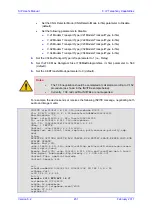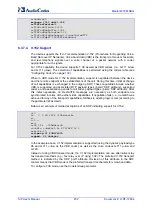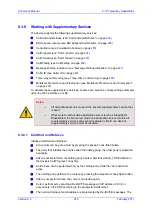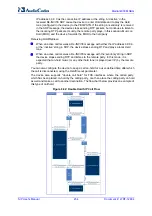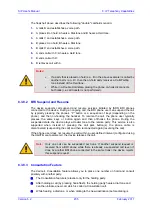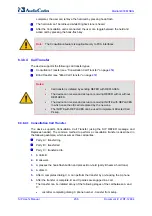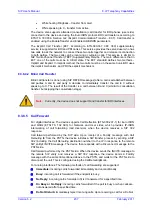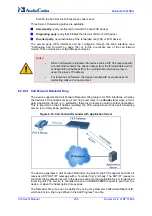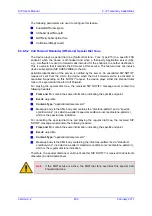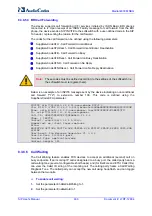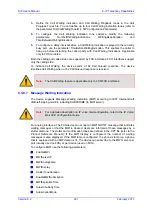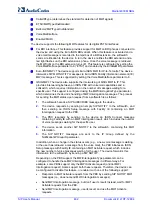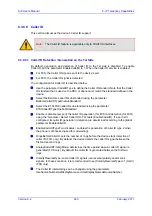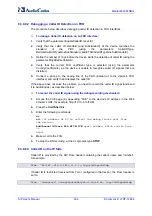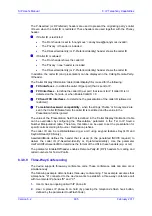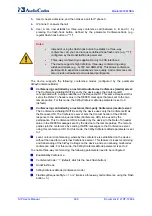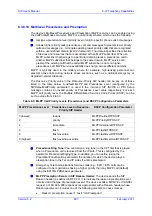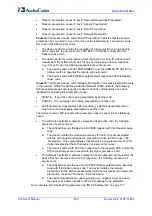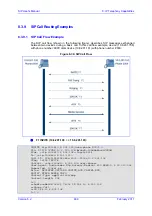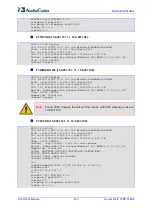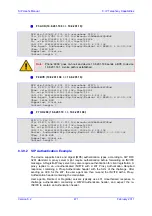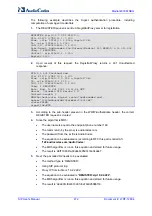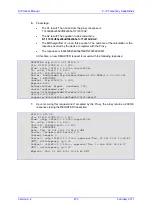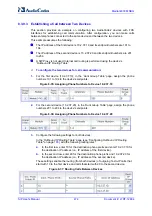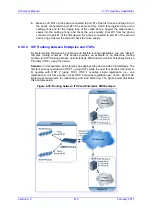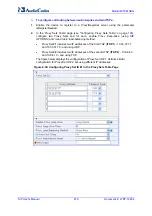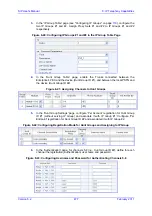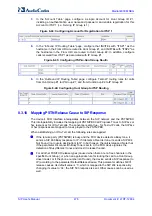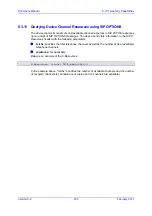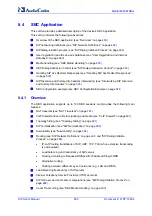
Version 6.2
465
February 2011
SIP User's Manual
8. IP Telephony Capabilities
The P-Asserted (or P-Preferred) headers are used to present the originating party’s caller
ID even when the caller ID is restricted. These headers are used together with the Privacy
header.
If Caller ID is restricted:
•
The From header is set to “anonymous” <[email protected]>
•
The ‘Privacy: id’ header is included
•
The P-Asserted-Identity (or P-Preferred-Identity) header shows the caller ID
If Caller ID is allowed:
•
The From header shows the caller ID
•
The ‘Privacy: none’ header is included
•
The P-Asserted-Identity (or P-Preferred-Identity) header shows the caller ID
In addition, the caller ID (and presentation) can be displayed in the Calling Remote-Party-
ID header.
The ‘Caller Display Information’ table (CallerDisplayInfo) is used for the following:
FXS interfaces
- to define the caller ID (per port) that is sent to IP.
FXO interfaces
- to define the caller ID (per port) that is sent to IP if caller ID isn’t
detected on the Tel side, or when EnableCallerID = 0.
FXS and FXO interfaces
- to determine the presentation of the caller ID (allowed or
restricted).
To maintain backward compatibility
- when the strings ‘Private’ or ‘Anonymous’ are
set in the Caller ID/Name field, the caller ID is restricted and the value in the
Presentation field is ignored.
The value of the ‘Presentation’ field that is defined in the ‘Caller Display Information’ table
can be overridden by configuring the ‘Presentation’ parameter in the ‘Tel to IP Source
Number Manipulation’ table. Therefore, this table can be used to set the presentation for
specific calls according to Source / Destination prefixes.
The caller ID can be restricted/allowed (per port) using keypad features KeyCLIR and
KeyCLIRDeact (FXS only).
AssertedIdMode defines the header that is used (in the generated INVITE request) to
deliver the caller ID (P-Asserted-Identity or P-preferred-Identity). Use the parameter
UseTelURIForAssertedID to determine the format of the URI in these headers (sip: or tel:).
The parameter EnableRPIheader enables Remote-Party-ID (RPI) headers for calling and
called numbers for Tel-to-IP calls.
8.3.8.9 Three-Way Conferencing
The device supports three-way conference calls. These conference calls can also occur
simultaneously.
The following example demonstrates three-way conferencing. This example assumes that
a telephone "A" connected to the device wants to establish a three-way conference call
with two remote IP phones "B" and "C":
1.
User A has an ongoing call with IP phone B.
2.
User A places IP phone B on hold (by pressing the telephone's flash hook button,
defined by the parameter HookFlashCode).
Summary of Contents for Mediant 800 MSBG
Page 2: ......
Page 366: ...SIP User s Manual 366 Document LTRT 12804 Mediant 800 MSBG Reader s Notes ...
Page 372: ...SIP User s Manual 372 Document LTRT 12804 Mediant 800 MSBG Reader s Notes ...
Page 390: ...SIP User s Manual 390 Document LTRT 12804 Mediant 800 MSBG Reader s Notes ...
Page 404: ...SIP User s Manual 404 Document LTRT 12804 Mediant 800 MSBG Reader s Notes ...
Page 616: ...SIP User s Manual 616 Document LTRT 12804 Mediant 800 MSBG Reader s Notes ...
Page 636: ...SIP User s Manual 636 Document LTRT 12804 Mediant 800 MSBG Reader s Notes ...
Page 652: ...SIP User s Manual 652 Document LTRT 12804 Mediant 800 MSBG Reader s Notes ...
Page 886: ...SIP User s Manual 886 Document LTRT 12804 Mediant 800 MSBG Reader s Notes ...

